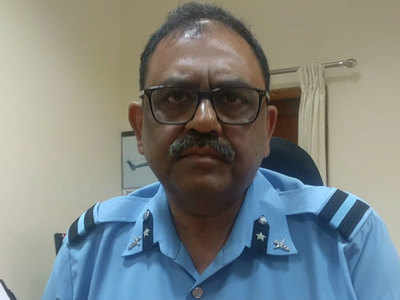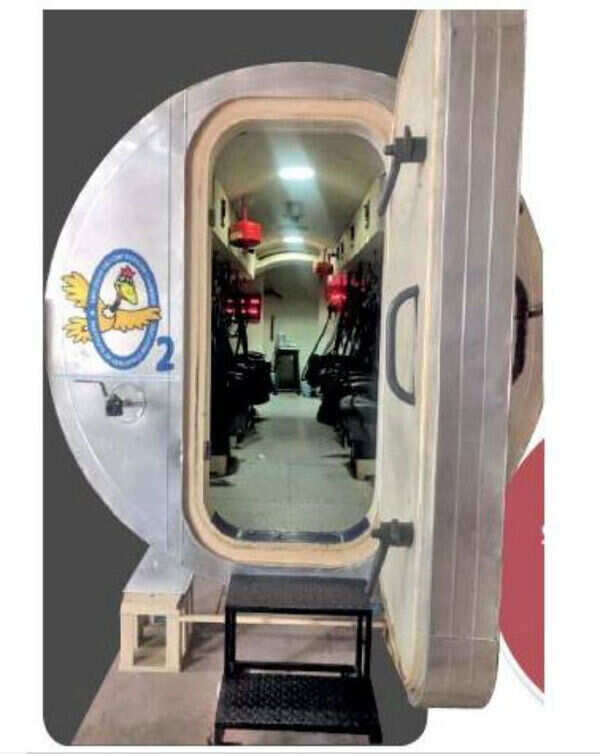- News
- India News
- India's manned space mission 2022: Need pool of 30 potential astronauts
Trending
This story is from September 23, 2018
India's manned space mission 2022: Need pool of 30 potential astronauts
Gaganyaan, the human spaceflight programme (HSP)'s chairman Sivan K has repeatedly emphasised that HSP won’t be an Isro-only mission. It’ll be a national mission with minds and institutions from all over India contributing. The mission needs a pool of 30 aspirants for astronaut selection along with simulators & human engineering and flight surgeon.

Trainees undergoing one of the simulations tests at Institute of Aerospace Medicine
Key Highlights
- Institute of Aerospace Medicine under the IAF will be responsible for astronaut selection
- The selection of astronauts is a complex and long process that’ll take 12-14 months
- From an initial pool of 30, six will be selected after rigorous evaluation, of whom three are likely to be picked for the mission
This August 15, India awoke to a promise from Prime Minister Narendra Modi, which when fulfilled, will put us in an elite company of countries. “We’ll send a son or daughter into space by 2022,” Modi announced, thus approving a project first seriously proposed in 2004.
And, even before his speech concluded at the Red Fort, the Indian Space Research Organisation (Isro), which’ll shoulder the responsibility of executing the proposed Human Spaceflight Programme (HSP)—Modi has named it Gaganyaan —got on its feet.
But as its Chairman Sivan K has said at least thrice in the 39 days since Gaganyaan’s announcement, this won’t be an Isro-only mission: “It’ll be a national mission with minds and institutions from all over India contributing.”
Besides, Air Commodore Anupam Agarwal, Commandant, IAM, says they’ve offered help in four other crucial areas: Basic and some advance training; human engineering of the crew capsule and the habitat module; assessment of cabin air quality and the flight surgeon support.
And, STOI, in an exclusive visit to IAM got an overview of the preparations and a peek into what the next few years hold.
Astronaut Selection
First things first, the astronaut selection. “...We’ll need a pool of 30 aspirants, of whom, 15 will be picked and given basic training. If the plan is to send three, we’ll shortlist three sets of three (nine) and let one set go about three months before the launch with the others remaining in the programme till launch date. This is my assessment,” Agarwal told STOI.
The selection of astronauts is a complex and long process that’ll take 12-14 months. The basic evaluation that’ll include psychological and medical tests involving a series of checks.
“This’ll take about three months as we have to ensure we pick the best, whose physical condition is among the best in India and they also have the right mental make up. A fixed set of tests will be conducted before selection,” Agarwal said.
After three months, a pool of potential astronauts will be selected who will then undergo a series of rigorous evaluation tests: How they deal with isolation; Can they handle physiological changes occurring during a spaceflight caused by extreme temperatures and otherwise; Disorientation and decision making and so on.
“At this stage the line between evaluation and training gets blurred,” Agarwal adds. Parallel to this, they will be trained on basic biology, physics, systems and even medicine among other things.
Experts from all these fields will be roped in, while IAM will teach them medicine. “They’ll need to take care of each other. They’ll be trained in all basic first aid, and other aspects. Eye injuries are common in space and they can make astronauts critical, while there’s something as simple as vomiting that can cause issues,” he says.
 The explosive decompression chamber that simulates various altitudes and helps train situations or accident or malfunction
The explosive decompression chamber that simulates various altitudes and helps train situations or accident or malfunction
Simulators & Human Engineering
For all this, IAM has a host of simulators: Systems that can simulate from -20 degree centigrade to 60 degrees; dry flotation simulators that can simulate microgravity, and others like the “head down tilt” simulator for the same purpose. There is a simulator that can create pressure six times that of atmospheric pressure (60 meters depth of sea water) and pressure which levels like those found at one lakh feet, which is one of the definitions of beginning of space. The institute also boasts of a human centrifuge – not too many countries have this – which creates high G-forces. The disorientation simulation, which helps train in 13 llusions that create disorientation, will help in training with motion sickness desensitisation.
Flight Surgeon
Agarwal said the flight surgeon support, a critical aspect of a spaceflight will be provided by IAM. “This is very crucial as each astronaut will have his own surgeon who will be with him from two years before the launch, during his stay at space and until he is recovered upon recovery,” he said.
He said currently the only advanced training that the IAM cannot offer astronauts is that of the systems which need specific simulators – “but this can be developed,” he says – and the complete parabolic flight training, for which India may have to look outside.
And, even before his speech concluded at the Red Fort, the Indian Space Research Organisation (Isro), which’ll shoulder the responsibility of executing the proposed Human Spaceflight Programme (HSP)—Modi has named it Gaganyaan —got on its feet.
But as its Chairman Sivan K has said at least thrice in the 39 days since Gaganyaan’s announcement, this won’t be an Isro-only mission: “It’ll be a national mission with minds and institutions from all over India contributing.”
One such institution, the Institute of Aerospace Medicine (IAM) under IAF, which evaluated tens of candidates before selecting Wing Commander (retd) Rakesh Sharma for his mission in 1984, will be responsible for astronaut selection as confirmed by Sivan.
Besides, Air Commodore Anupam Agarwal, Commandant, IAM, says they’ve offered help in four other crucial areas: Basic and some advance training; human engineering of the crew capsule and the habitat module; assessment of cabin air quality and the flight surgeon support.
Project Gaganyaan: How the dry flotation simulator helps train astronauts for zero gravity conditions
And, STOI, in an exclusive visit to IAM got an overview of the preparations and a peek into what the next few years hold.
Astronaut Selection
First things first, the astronaut selection. “...We’ll need a pool of 30 aspirants, of whom, 15 will be picked and given basic training. If the plan is to send three, we’ll shortlist three sets of three (nine) and let one set go about three months before the launch with the others remaining in the programme till launch date. This is my assessment,” Agarwal told STOI.
The selection of astronauts is a complex and long process that’ll take 12-14 months. The basic evaluation that’ll include psychological and medical tests involving a series of checks.
“This’ll take about three months as we have to ensure we pick the best, whose physical condition is among the best in India and they also have the right mental make up. A fixed set of tests will be conducted before selection,” Agarwal said.
After three months, a pool of potential astronauts will be selected who will then undergo a series of rigorous evaluation tests: How they deal with isolation; Can they handle physiological changes occurring during a spaceflight caused by extreme temperatures and otherwise; Disorientation and decision making and so on.
“At this stage the line between evaluation and training gets blurred,” Agarwal adds. Parallel to this, they will be trained on basic biology, physics, systems and even medicine among other things.
Experts from all these fields will be roped in, while IAM will teach them medicine. “They’ll need to take care of each other. They’ll be trained in all basic first aid, and other aspects. Eye injuries are common in space and they can make astronauts critical, while there’s something as simple as vomiting that can cause issues,” he says.

Simulators & Human Engineering
For all this, IAM has a host of simulators: Systems that can simulate from -20 degree centigrade to 60 degrees; dry flotation simulators that can simulate microgravity, and others like the “head down tilt” simulator for the same purpose. There is a simulator that can create pressure six times that of atmospheric pressure (60 meters depth of sea water) and pressure which levels like those found at one lakh feet, which is one of the definitions of beginning of space. The institute also boasts of a human centrifuge – not too many countries have this – which creates high G-forces. The disorientation simulation, which helps train in 13 llusions that create disorientation, will help in training with motion sickness desensitisation.
Flight Surgeon
Agarwal said the flight surgeon support, a critical aspect of a spaceflight will be provided by IAM. “This is very crucial as each astronaut will have his own surgeon who will be with him from two years before the launch, during his stay at space and until he is recovered upon recovery,” he said.
He said currently the only advanced training that the IAM cannot offer astronauts is that of the systems which need specific simulators – “but this can be developed,” he says – and the complete parabolic flight training, for which India may have to look outside.
Watch: This Air Force centre will help train Indian astronauts for mission 'Gaganyaan'
End of Article
FOLLOW US ON SOCIAL MEDIA










